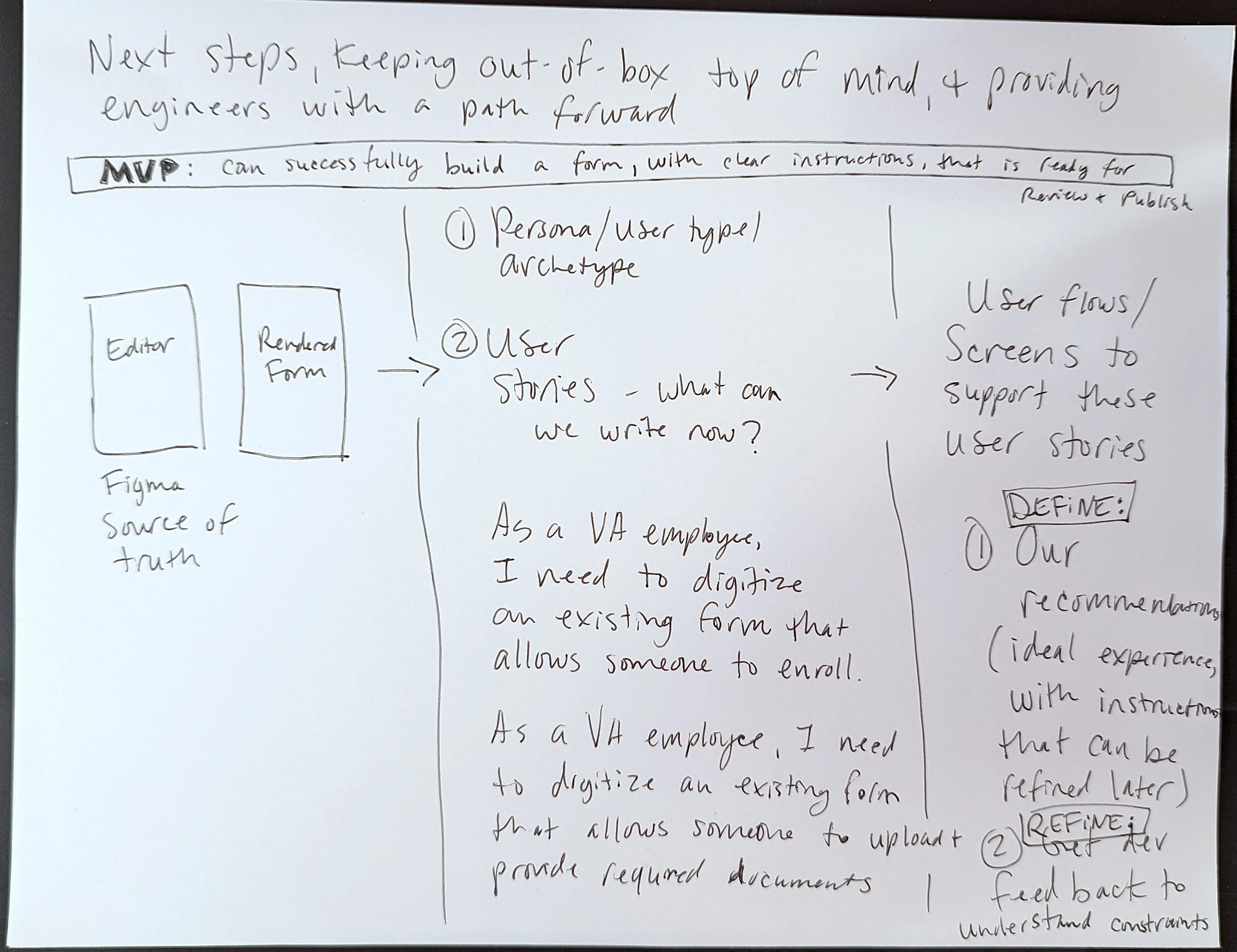Goals
With a focus on simple forms, it was determined that the VA Form Builder needed to be a no-code tool to help non-technical VA staff, separate from the forms teams, efficiently create and manage digital forms. This would set the stage for our primary goal of streamlining the digitization of over 260 backlogged forms, reducing delays for Veterans, and enhancing the overall experience.
Key goals included:
Enable faster publishing of forms without custom engineering; VA staff can launch or update a form in days instead of months
Embed accessibility and design system compliance into the workflow
Reduce governance review effort and error-prone manual processes
Empower internal users while preserving Veteran trust and usability
Veterans experience shorter forms and fewer errors
Faster benefit delivery due to less manual processing
Complete MVP within 12 months
Process
I co-led the design of this tool, focusing on ease of use, scalability, and accessibility. We relied heavily on reviews and collaboration with a VA forms accessibility expert, as well as guidance from our product owner.
During this initiative, I:
Owned the UX strategy, user flows, and high-fidelity UI design
Collaborated closely with engineering and product to shape (and reshape) a feasible MVP roadmap
Worked transparently and in low-fidelity to encourage frequent feedback and early alignment
Structured stakeholder demos and feedback loops around rapid iteration
Documented design decisions, component logic, and handoff workflows for future teams
Facilitated weekly working sessions with VA accessibility and governance experts
Aligned the interface with VA’s brand, voice, and inclusive design principles
Early sketch from discovery and strategy discussions.
Another early sketch from discovery and strategy discussions.
Result
Design highlights
Step-by-Step Form Builder UI: Guides staff through form creation using pre-approved field types and logic
Preview-as-you-build Mode: Shows how the form will appear to the Veteran, reducing the need for design knowledge
Built-in Accessibility & Validation: Reduces the risk of errors by using form components aligned with WCAG, the VA Design System, and VA Content and Accessibility standards
Submission-Ready Output: Generates a governance-reviewable package for approval and publication
Findable, Documented Design Decisions: Linked throughout GitHub, Mural, Slack, and sprint tools to support continuity and reuse
Key impact
Delivered a proof of concept in under 12 months that would enable non-technical staff to participate in digital transformation
Supported the VA’s service mission by reducing form turnaround time
Embedded accessibility and user-centered design from the start
Recognized by VA stakeholders as meeting and/or exceeding performance and design expectations
Reflection
Challenges We Navigated
No VA precedent for no-code tools
Short MVP timeline (under 12 months)
An even shorter design timeline, as I joined the project 3 months in, with design already underway
CMS platform limitations and third-party dependencies
Complexity in guiding non-designers through form best practices and flow logic with conditional inputs
Limited availability of usability testing opportunities
Despite meeting the success criteria, funding for continuation was not renewed, so the team ensured documentation was robust enough for a future team to own and adapt this tool
Wins
This project was a rare opportunity to address systemic digital equity from within a government agency. The most rewarding part was designing a tool that enabled others to scale accessibility and service delivery, even after our work wrapped.
I’m especially proud of the way we:
Built strong cross-functional alignment through structured, inclusive working sessions
Pivoted the design direction in response to new constraints
Made complex form logic accessible to non-designers
Left behind thorough documentation that ensures continuity for future teams or technologies
